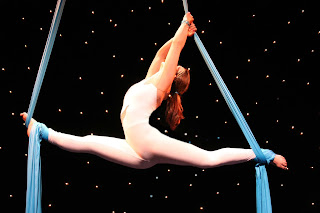It was a
Sunday afternoon when I was thinking to write a new post on my blog. I had put
lots of pressure on my brain still couldn’t think something interesting to
write about. Some hours later I switched colours channel which was airing an
episode of” jhalak dikhla ja”.The contestants were showing off their talent
through some dance form or the other. Out of 8 contestants 2 of them performed
on aerials and a form of rhythmic gymnastics. Knowing the fact that few of good
shows are left on television, I still switched to another channel hoping to see
something different and Indian. Again I could see aerial act with also
promotion of such classes in India, It is really great that India welcomes
western forms of dancing and promotes it to a bigger level (as discussed in my
earlier posts) but then balance of both dances forms is very important. Like in
United States, jazz and contemporary are their dance forms and classical dances
are still treated as guests. It is a possession if a foreigner is trained in
classical dancing as its rare for them. But I think here in India dancing to
kathak or kuchupidi on a media platform would be a priced possession as we
hardly get to see it.
Today this
post will be about two such forms that have overshadowed Indian dancing (In the
domain of my blog topic).one is the rhythmic gymnastics and the other is aerial
or acrobatics.
Rhythmic
gymnastics is an exercise done in a dance form, Earlier we could see such art
form either in Olympic Games or any other game competition. Today searching for
such an art form on media level won’t be a difficult task. Rhythmic gymnastics
grew out of the ideas of Jean-Georges Noverre (1727–1810), François Delsarte
(1811–1871), and Rudolf Bode (1881–1970), who all believed in movement
expression, where one used dance to express oneself and exercise various body
parts. Peter Henry Ling further developed this idea in his 19th-century Swedish
system of free exercise, which promoted "aesthetic gymnastics", in
which students expressed their feelings and emotions through bodily movement.
And now since some years this gymnastic form is being practiced as dance in
India.
Just like
rhythmic gymnastics another dance form that is being promoted by India in large
scale is the Aerial dancing. Aerial modern pieces, whether solo or ensemble,
often involve partnering. The apparatus used has its own motion, which changes
the way a dancer must move in response. The introduction of a new element
changes the dancer’s balance, centre, and orientation in space. Aerial was
incepted in Boulder Colorado in July 1999.Since some 3 years we can see aerial
techniques being practiced in India and seeing it grow brilliantly.
Introduction
of aerial and rhythmic gymnastics to Indian dancing ground is commendable but
if this effort would be put into Indian dances (the one discussed in my
previous blogs)then at least ethnicity would be retained. I would request all
the readers of this blog to share the word because ethnicity starts from us.

